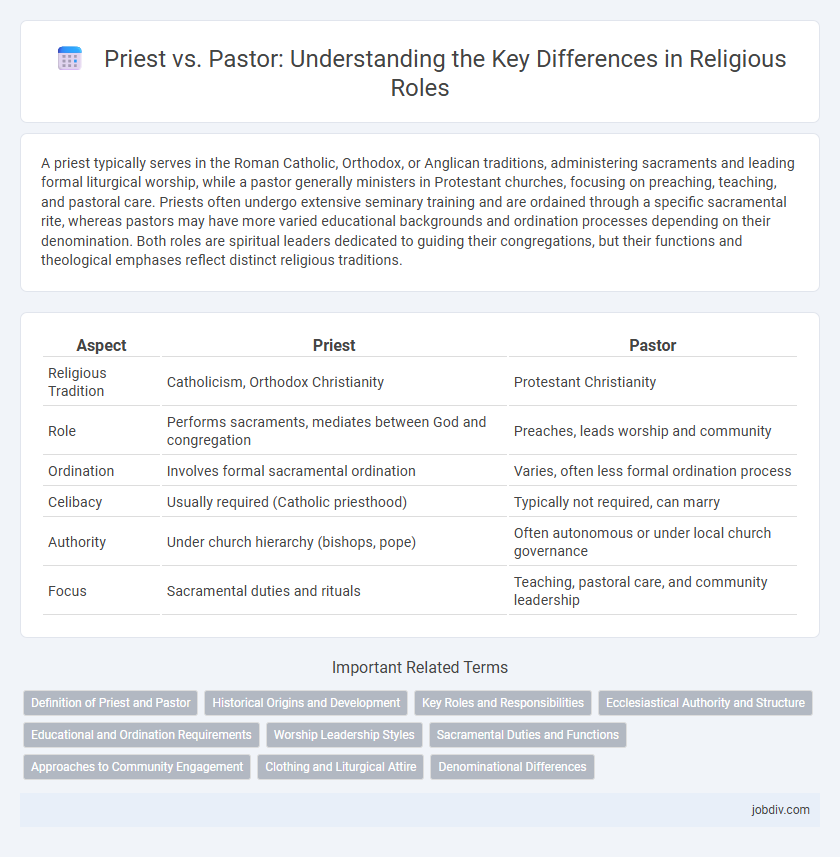A priest typically serves in the Roman Catholic, Orthodox, or Anglican traditions, administering sacraments and leading formal liturgical worship, while a pastor generally ministers in Protestant churches, focusing on preaching, teaching, and pastoral care. Priests often undergo extensive seminary training and are ordained through a specific sacramental rite, whereas pastors may have more varied educational backgrounds and ordination processes depending on their denomination. Both roles are spiritual leaders dedicated to guiding their congregations, but their functions and theological emphases reflect distinct religious traditions.
Table of Comparison
| Aspect | Priest | Pastor |
|---|---|---|
| Religious Tradition | Catholicism, Orthodox Christianity | Protestant Christianity |
| Role | Performs sacraments, mediates between God and congregation | Preaches, leads worship and community |
| Ordination | Involves formal sacramental ordination | Varies, often less formal ordination process |
| Celibacy | Usually required (Catholic priesthood) | Typically not required, can marry |
| Authority | Under church hierarchy (bishops, pope) | Often autonomous or under local church governance |
| Focus | Sacramental duties and rituals | Teaching, pastoral care, and community leadership |
Definition of Priest and Pastor
A priest is a religious leader authorized to perform sacred rituals and administer sacraments within certain Christian traditions, such as Catholicism, Orthodoxy, and Anglicanism. Priests often serve as mediators between God and congregation, with roles including celebrating the Eucharist, hearing confessions, and providing spiritual guidance. In contrast, a pastor typically refers to a Protestant Christian minister responsible for leading a congregation, preaching, and offering pastoral care, emphasizing teaching and community leadership.
Historical Origins and Development
The term "priest" originates from the Greek word "presbyteros," meaning elder, and developed within early Christian and Jewish religious traditions to denote clergy responsible for sacramental rites and temple worship. The title "pastor," derived from the Latin for shepherd, emerged prominently during the Protestant Reformation as a designation for church leaders focusing on preaching, teaching, and guiding congregations. Historically, priests maintained sacramental authority in Roman Catholicism and Eastern Orthodoxy, while pastors assume pastoral care roles in Protestant denominations, reflecting divergent theological and ecclesiastical developments.
Key Roles and Responsibilities
Priests primarily administer sacraments, lead liturgical ceremonies, and offer spiritual guidance within sacramental traditions such as Catholicism, Orthodoxy, and Anglicanism. Pastors focus on preaching, teaching, and shepherding congregations, particularly in Protestant denominations, emphasizing community leadership and personal counseling. Both roles involve pastoral care, but priests have sacramental authority while pastors emphasize sermon delivery and community building.
Ecclesiastical Authority and Structure
Priests often hold sacramental authority within hierarchical religious traditions such as Catholicism and Orthodoxy, serving as intermediaries between God and the congregation through rites like the Eucharist. Pastors typically operate in Protestant denominations, emphasizing pastoral care, preaching, and community leadership within congregational or presbyterian church structures. Ecclesiastical authority for priests is vested through apostolic succession and church hierarchy, while pastors derive authority through ordination and the collective governance of their local or denominational bodies.
Educational and Ordination Requirements
Priests typically undergo extensive theological education, often earning degrees from seminaries or divinity schools, followed by formal ordination through established religious institutions such as the Catholic Church, which mandates celibacy and sacramental authority. Pastors usually complete a theological degree or equivalent training, with ordination processes varying widely across Protestant denominations, focusing on preaching, pastoral care, and community leadership. Educational requirements for priests are generally more rigorous and standardized, while pastoral ordination emphasizes practical ministry and may have more flexible academic prerequisites.
Worship Leadership Styles
Priests typically lead worship through structured liturgies and sacramental rituals rooted in tradition, emphasizing formal ceremonies in Catholic, Orthodox, and Anglican contexts. Pastors often adopt a more informal, relational style of worship leadership, incorporating contemporary music, interactive sermons, and community engagement common in Protestant evangelical churches. The distinction in worship leadership styles reflects differing theological emphases and congregational expectations within Christian denominations.
Sacramental Duties and Functions
Priests primarily administer the seven sacraments, including the Eucharist, Confession, and Anointing of the Sick, as mandated by Catholic and Orthodox traditions. Pastors typically focus on preaching, pastoral care, and leading worship services within Protestant denominations, often emphasizing community guidance over sacramental functions. The sacramental duties of priests involve a sacred authority believed to confer grace, whereas pastors generally facilitate spiritual growth through teaching and counseling.
Approaches to Community Engagement
Priests traditionally engage with their community through sacramental ministry and formal liturgical roles, emphasizing rituals and confession within the Catholic Church. Pastors, often found in Protestant denominations, prioritize relational ministry and informal gatherings to foster community bonds and spiritual growth. Both roles shape their approach to community engagement by aligning with doctrinal practices and pastoral care tailored to their congregations' needs.
Clothing and Liturgical Attire
Priests traditionally wear specific liturgical vestments such as the cassock, alb, chasuble, and stole, which vary according to the liturgical season and sacramental functions, symbolizing their role in the Catholic or Orthodox Church. Pastors, especially in Protestant denominations, often wear simpler attire like a clerical collar and black shirt or a pulpit robe, reflecting a less formal approach to worship leadership. The distinctive clothing of priests emphasizes sacramental authority, while pastors' attire highlights accessibility and preaching within congregational settings.
Denominational Differences
Priests primarily serve in Catholic, Orthodox, and some Anglican traditions, where they administer sacraments like the Eucharist and Confession, emphasizing apostolic succession and liturgical rituals. Pastors are found mainly in Protestant denominations such as Baptist, Methodist, and Lutheran churches, focusing on preaching, teaching, and pastoral care within a congregational governance structure. These denominational differences highlight varying theological interpretations and worship styles that shape the distinct roles of priests and pastors.
Priest vs Pastor Infographic

 jobdiv.com
jobdiv.com